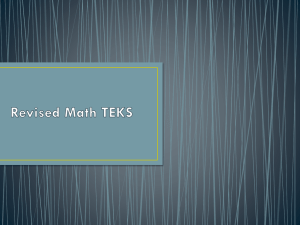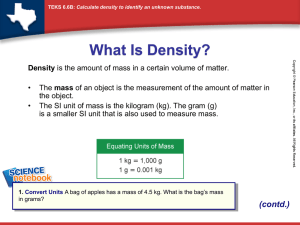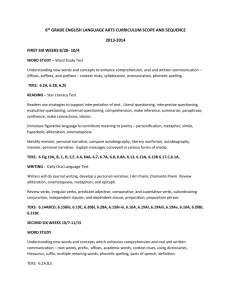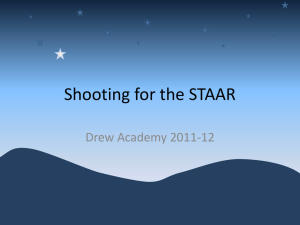Light & Optics Exam Review
advertisement
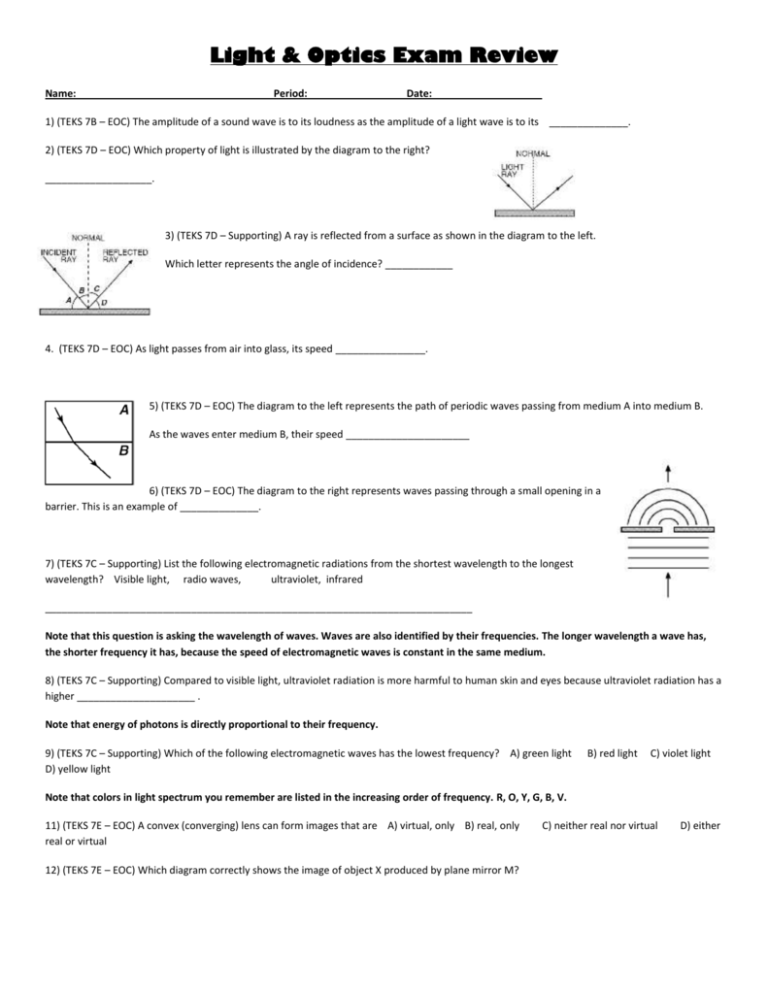
Light & Optics Exam Review Name: Period: Date: 1) (TEKS 7B – EOC) The amplitude of a sound wave is to its loudness as the amplitude of a light wave is to its ______________. 2) (TEKS 7D – EOC) Which property of light is illustrated by the diagram to the right? ___________________. 3) (TEKS 7D – Supporting) A ray is reflected from a surface as shown in the diagram to the left. Which letter represents the angle of incidence? ____________ 4. (TEKS 7D – EOC) As light passes from air into glass, its speed ________________. 5) (TEKS 7D – EOC) The diagram to the left represents the path of periodic waves passing from medium A into medium B. As the waves enter medium B, their speed ______________________ 6) (TEKS 7D – EOC) The diagram to the right represents waves passing through a small opening in a barrier. This is an example of ______________. 7) (TEKS 7C – Supporting) List the following electromagnetic radiations from the shortest wavelength to the longest wavelength? Visible light, radio waves, ultraviolet, infrared ____________________________________________________________________________ Note that this question is asking the wavelength of waves. Waves are also identified by their frequencies. The longer wavelength a wave has, the shorter frequency it has, because the speed of electromagnetic waves is constant in the same medium. 8) (TEKS 7C – Supporting) Compared to visible light, ultraviolet radiation is more harmful to human skin and eyes because ultraviolet radiation has a higher _____________________ . Note that energy of photons is directly proportional to their frequency. 9) (TEKS 7C – Supporting) Which of the following electromagnetic waves has the lowest frequency? A) green light D) yellow light B) red light C) violet light Note that colors in light spectrum you remember are listed in the increasing order of frequency. R, O, Y, G, B, V. 11) (TEKS 7E – EOC) A convex (converging) lens can form images that are A) virtual, only B) real, only real or virtual 12) (TEKS 7E – EOC) Which diagram correctly shows the image of object X produced by plane mirror M? C) neither real nor virtual D) either 13) (TEKS 7D – EOC) Which phenomenon is represented by the diagram to the right? A) refraction B) diffraction C) reflection D) polarization 14) (TEKS 7E – EOC) Which diagram below shows the path of light rays as they pass from an object at 2F through a converging lens to the image formed at 2F1? 15) (TEKS 7E – EOC) The diagram below represents a convex lens being used to form the image of an object. The distance from the center of the lens to the object is 0.060 meter. The distance from the center of the lens to the image is 0.120 meter. The focal length of the lens is _________. 16) The spectrum of visible light emitted during transitions in excited hydrogen atoms is composed of blue, green, red, and violet lines. What characteristic of light determines the amount of energy carried by a photon of the light? _______________ 17) (TEKS 7E – EOC) An object is placed 0.40 meter in front of a convex (converging) lens whose focal length is 0.30 meter. What is the image distance? A) 5.8 m B) 1.2 m C) 0.17 m D) 0.83 m 18) (TEKS 7E – EOC) A crown glass converging lens has a focal length of 0.10 meter. An object is placed 0.30 meter from the lens. How far from the lens will an image of the object be formed? A) 0.10 m B) 0.20 m C) 0.30 m D) 0.15 m 19) (TEKS 7C – EOC) What type of wave requires a material medium through which to travel? A) sound B) infrared C) electromagnetic D) radio 20) (TEKS 7C – Supporting) What is the speed of a radio wave in a vacuum? A) 3.00 x 108 m/s B) 1.13 x 103 m/s C) 0 m/s D) 3.31 x 102 m/s 21) (TEKS 7C – EOC) The diagram to the left represents a light ray striking the boundary between air and glass. What would be the angle between this light ray and its reflected ray? A) 120.° B) 150. ° C) 30. ° D) 60. ° 22) (TEKS 7C – EOC) The diagram to the right represents a light ray reflecting from a plane mirror. What is the angle of reflection for the light ray? A) 35° B) 25° C) 65° D) 50. ° 23) (TEKS 7D – Supporting) A straight glass rod appears to bend when placed in a beaker of water, as shown in the diagram below. What is the best explanation for this phenomenon? 24) (TEKS 7D – Supporting) When a light wave enters a new medium and is refracted, there must be a change in the light wave's _______. 25) (TEKS 7D – EOC) A wave of constant wavelength diffracts as it passes through an opening in a barrier. As the size of the opening is increased, the diffraction effects A) increase B) remain the same C) decrease 26) (TEKS 7C – EOC) A microwave and an x-ray are traveling in a vacuum. Compared to the wavelength and period of the microwave, the x-ray has a wavelength that is A) longer and a period that is shorter B) shorter and a period that is shorter C) longer and a period that is longer D) shorter and a period that is longer 27) (TEKS 7C – Supporting) A television remote control is used to direct pulses of electromagnetic radiation to a receiver on a television. This communication from the remote control to the television illustrates that electromagnetic radiation A) is a longitudinal wave B) transfers energy without transferring mass C) diffracts and accelerates in air D) possesses energy inversely proportional to its frequency 28) (TEKS 8A – EOC) Light demonstrates the characteristics of A) both particles and waves B) waves, only C) particles, only D) neither particles nor waves 29) (TEKS 7C/8A – EOC) A variable-frequency light source emits a series of photons. As the frequency of the photon increases, what happens to the energy and wavelength of the photon? ___________________________________________________________________________ 30) (TEKS 8B – EOC) What is the significance of spectral lines? A) They occur when atoms absorb light. B) They are unique patterns of light emitted by different molecules or atoms. C) The pattern of lines produced is the same for all molecules.




